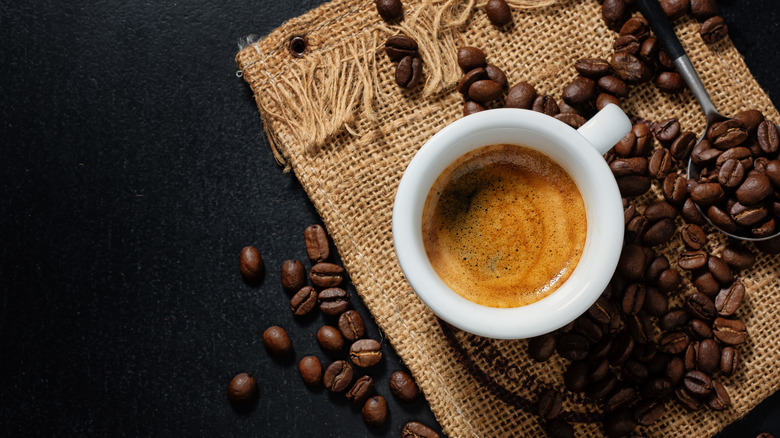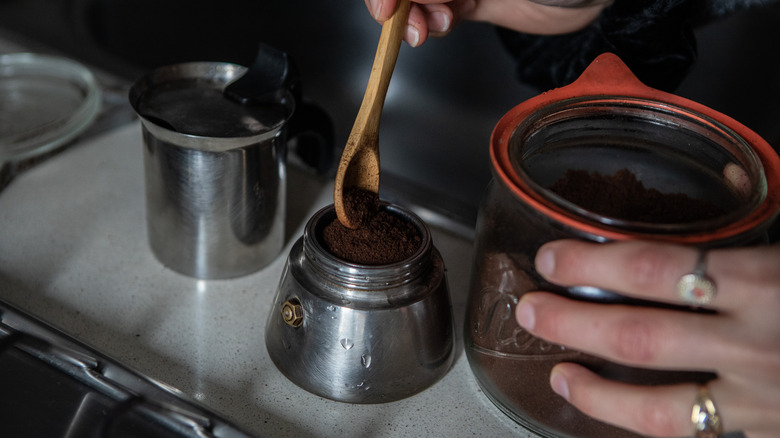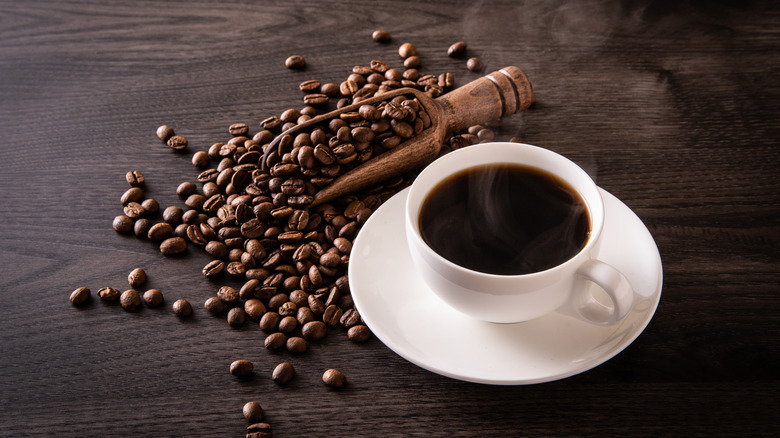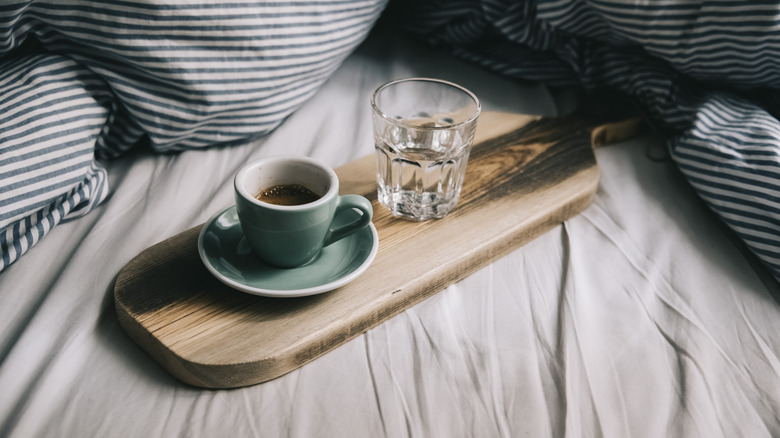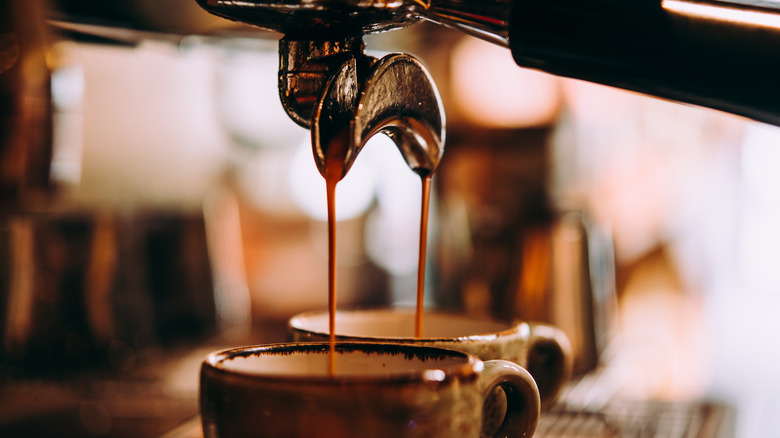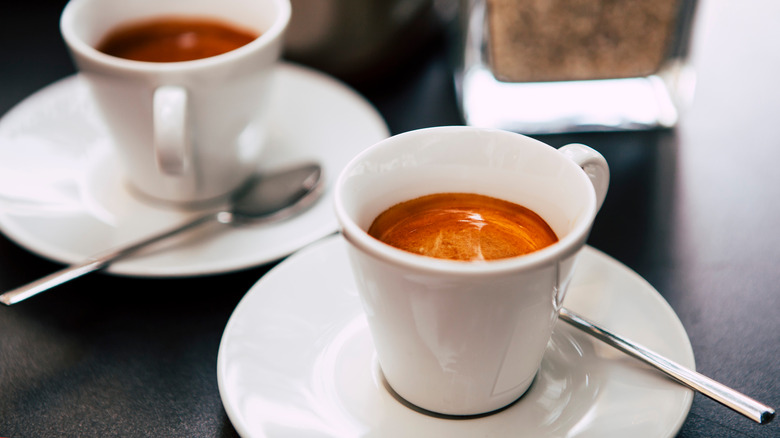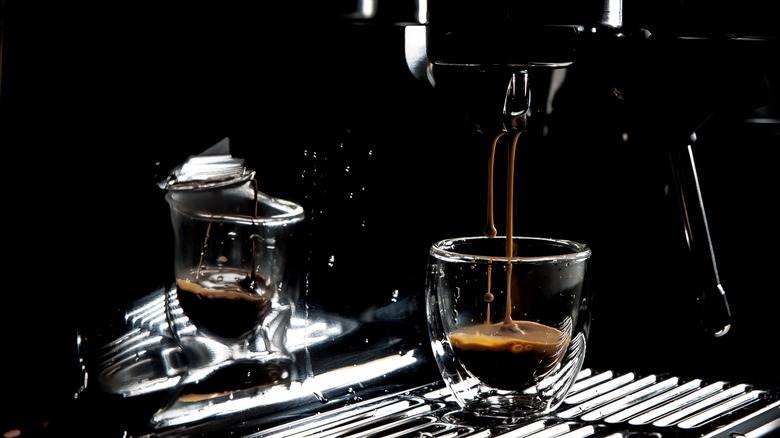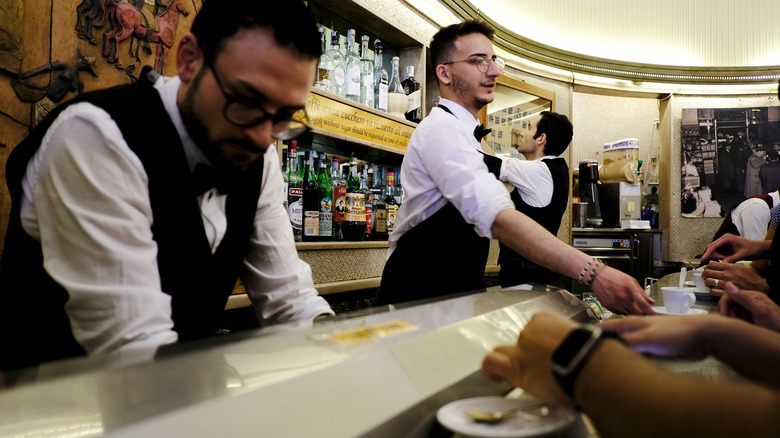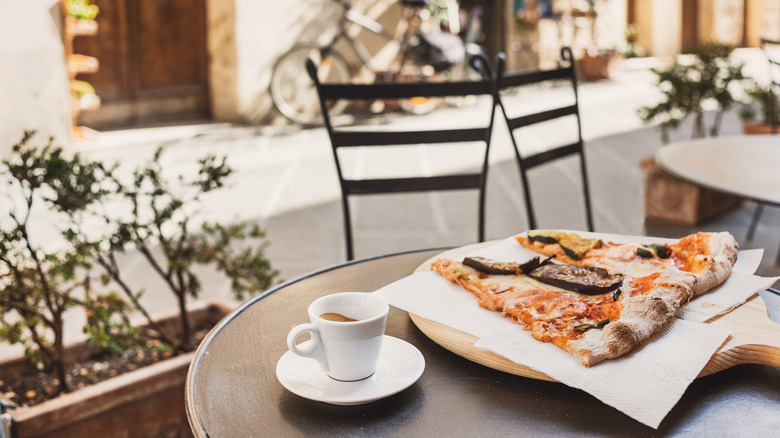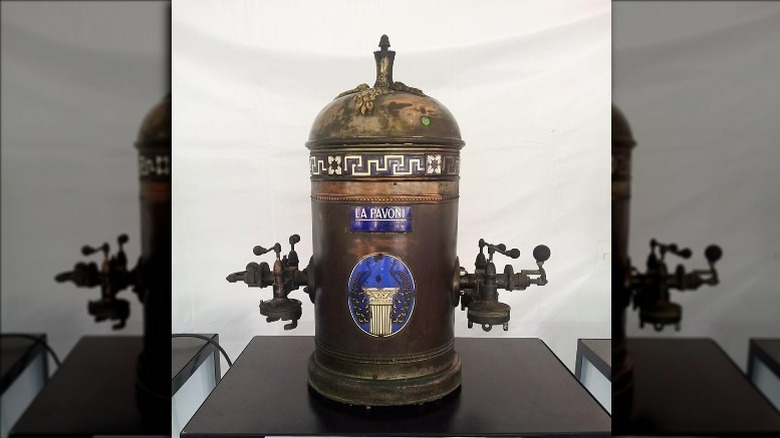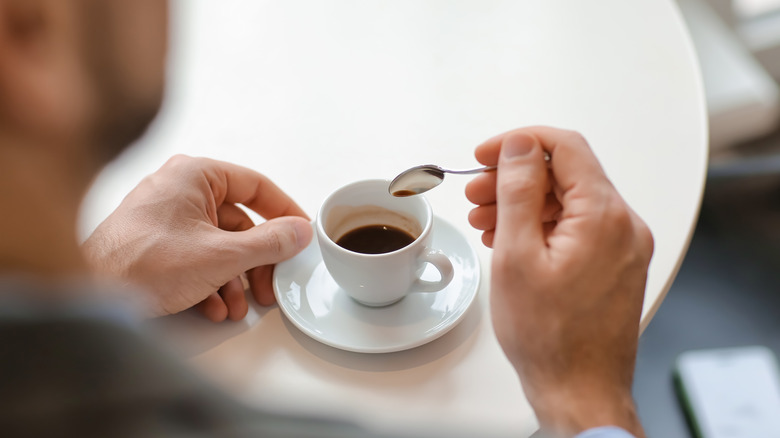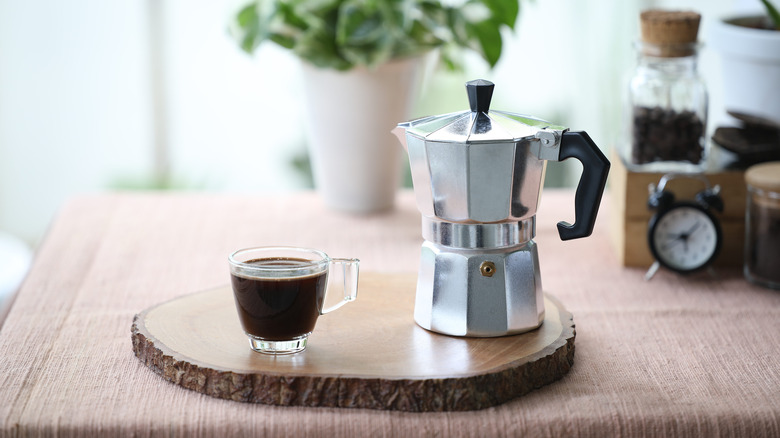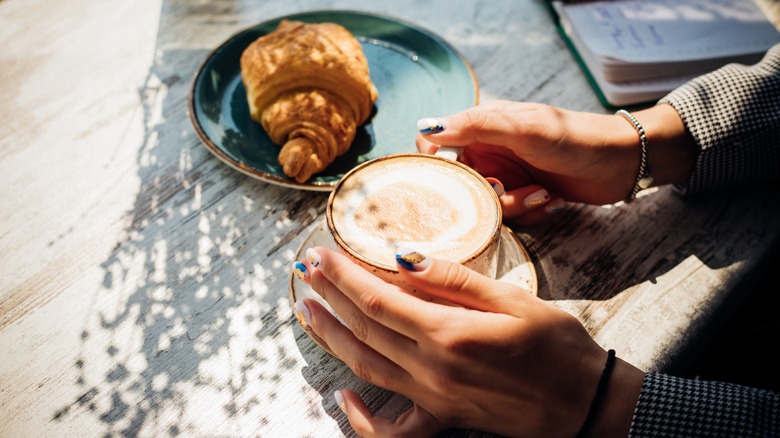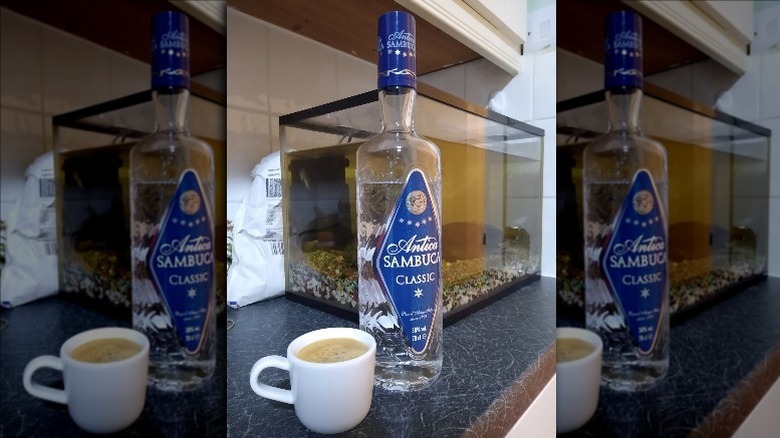The Untold Truth Of Espresso
There are few joys as reliable as an espresso first thing in the morning (or any time of day, really). Espresso comes in a small cup and may very much be dwarfed by a venti Starbucks number, but that's not to say it doesn't pack a punch. It feels like a shot of energy into your veins, yet it somehow manages to offer a rich flavor that many coffee drinkers can't get enough of. And when you figure out how to make espresso in your own home? Forget about it — you're going to be an espresso person for life.
But how much do you really know about this famous Italian coffee drink? If you're like most of us, not much. That's why we did some digging to uncover the untold truths of espresso. We wanted to dive into the history of the beverage, along with the information you need to order — or prepare — your espresso correctly. So, grab an espresso (or your favorite espresso-based drink), sit back, and learn everything you've ever wanted to know about this beverage. We're feeling excited jitters already.
Espresso isn't a certain bean or roast — it's a method of preparation
A lot of people, even those who love espresso, seem to be confused about what exactly it is. Is it a certain type of bean, a specific process for roasting, or just a fancy Italian word for coffee? Actually, it's none of the above. Rather, it's simply a method of preparing coffee. According to Smithsonian Magazine, it involves forcing highly pressurized water over coffee grounds. And per the coffee brand Illy, there are set standards for exactly how to do this. For starters, the water should be between 88 and 93 degrees, poured over seven grams of coffee grounds. As for the end result, it should not total more than one ounce of coffee.
Of course, not everyone making espresso sticks to these tight standards, but a good cup will probably come close. So, the next time you're buying beans and wondering which type are espresso beans, you can relax. Any bean will do, provided you have the equipment to get the job done right.
It has more caffeine than coffee ... kind of
When you're super tired or have a long day ahead of you, you may feel like packing in as much caffeine as you can get. Sure, a Starbucks Frappuccino may taste good, but is it going to give you the energy you need to get you through the day? Likely not. Therefore, many coffee drinkers want something stronger than an average cup of coffee, and they believe that espresso was made for times like these. And they're right ... kind of. But they're also completely wrong.
The Spruce Eats tells us that espresso does in fact have a higher caffeine content than drip coffee, so it may seem like the clear option when you need a burst of energy. However, you have to remember that espresso serving sizes are quite small, so depending on how much you're drinking, you might be getting less caffeine than from an average cup of coffee. Most espressos contain about 75 mg of caffeine, while a cup of coffee can come in anywhere from 80 to 200 mg of caffeine. If you love espresso and want to make sure you're getting as much caffeine as you need to power through the day, you can always ask for a doppio or a double shot. This will get your caffeine tally closer to a strong cup of coffee.
It's usually served in a special cup
Making your espresso at home? As long as your machine can accommodate it, you can use just about any type of mug you want. But when you go out for an espresso, you might notice that instead of being served in a standard coffee mug, you'll probably get a tiny cup that looks like it belongs in a dollhouse. This is a cup made especially for espresso, and The Coffee Maven explains that it's called a demitasse.
If you think that looks strange for an Italian word, well you're right, because it's not actually Italian. It actually means half cup in French, since a demitasse can hold three ounces of liquid, while a standard coffee cup can hold six. Therefore, a demitasse holds half of a standard coffee mug.
No need to pull this word out of your back pocket at your local coffee shop unless you're really trying to impress. Your baristas are going to know what you mean when you say cup in reference to an espresso. But hey, if you want to look like you know what you're talking about, use your new French vocab however you please.
Espressos are kept inexpensive by law in Italy
The United States isn't generally known for its affordability when it comes to housing, healthcare, and yes, even coffee. At most coffee shops countrywide, you're going to shell out at least $2 to $3 for a shot of espresso. And when we consider how much espresso we want to drink throughout the day, that seems like a lot of money flying out of our pockets. Over in Italy, espresso drinkers don't have the same problem.
Per Quartz, most Italians are paying around $1 for an espresso, and sometimes even less. This isn't because coffee beans are less expensive in Europe. Rather, there's actually a law to keep espresso prices down. Starting in 1911, municipalities in Italy have had the responsibility of putting a cap on the price of espresso. That price changes according to where in the country you're located and it has certainly increased since the early 1900s. But still, the idea is that everyone should be able to afford an espresso. Just like water, it's a resource that the masses should have access to.
This democratization of espresso likely wouldn't be as popular in the U.S., considering the rise of trendy high-end coffee shops charging exorbitant prices for a simple cup of espresso. But we dream of a day when we can drink as much coffee as we want without worrying about breaking the day's budget.
The texture is different than that of coffee
The first time you take a sip of espresso, you'll notice that something is distinct. It doesn't taste that different from drip coffee, but there's still something that sets it apart from other coffees you've had in the past. This sensation probably comes down to the texture, as espresso is unique compared with other coffee drinks.
The Spruce Eats notes that when you drink espresso, you should be on the lookout for a rich and creamy consistency. It likely feels fuller in your mouth than other coffees, which is partially due to the crema, or the foam on the surface of your espresso that makes it look so appealing. This stuff comes from the mingling of air and oil in the coffee, resulting in tiny bubbles that add a pleasant creaminess to your drink. The thick consistency of crema is also what makes your espresso taste so amazing, and it gives your drink an aftertaste that feels a lot more substantial than what you'd experience from a cup of drip coffee.
You can choose between a ristretto and a lungo
There are so many different ways to enjoy espressos and you'll find a variation for everyone. Before you order an espresso at a coffee bar, it pays to know the characteristics of the various styles to ensure you're getting exactly what you want. You may be most familiar with a ristretto, which according to Quartz, is your typical small shot of espresso. It's super concentrated, with a lot of coffee and just a touch of water.
But if you don't like that ultra-concentrated flavor, you may be looking for something else. No problem — consider ordering a lungo instead. A lungo contains more water, so your sips of coffee won't be as overwhelming. If you're looking for a touch of creaminess, add some milk to make a macchiato. All these preparations taste slightly different, but they all pack the same amount of caffeine. It just depends on whether you prefer to sip your coffee or down it all in one shot.
Italians often drink their espresso at the bar — and quickly
It's no secret that U.S. and Italian coffee cultures are very, very different. For example, when you're at a coffee shop in the U.S., chances are you're going to order your drink and wait several minutes to receive it after answering all kinds of questions about how you want it prepared. Then, you might sit down at a table, perhaps with your laptop open, and stay there for an hour or more, becoming engrossed in your work and just enjoying the atmosphere. But in Italy, sitting down for an hour with an espresso might seem strange. This is partly because as Life in Italy notes, sitting down to enjoy your espresso usually means a price increase (up to four times more in desirable locations).
As Quartz tells us, it's very common for coffee drinkers in Italy to get their espresso at the bar, down it in one big swig, and get on with their day. Sometimes, you won't even go to a coffee shop at all — a gas station gets the job done just right. And though U.S. coffeehouse menus are often ridiculously lengthy featuring all kinds of different flavors and add-ons, you won't have that much choice in an Italian coffee shop. There, it's not about the options, it's about the quality. So just a warning: Probably don't ask for sugar-free vanilla syrup at the corner coffee shop you visit when in Rome.
You don't just drink it in the morning
You've likely heard before that you should only order a cappuccino in the morning, or at least before lunch. (Of course, you can order a cappuccino any time you want, but you may get some strange looks. Just ignore them!) It would make sense then, to think that the same is true for espresso, however, we're happy to report that you don't have to limit your espresso-drinking activities to the early hours of the morning. Actually, this is a drink that you can easily enjoy all day long — with some moderation, of course.
It's no surprise that espresso is commonly consumed in the morning, but it's also popular after a meal. Some restaurants in the U.S. will offer this kind of service, but it's much more common in Europe. Never underestimate the pleasure of an espresso after you've eaten a three-course meal with plenty of wine and good company. For those who are sensitive to caffeine at night, this may not be a great idea. But if you think you can manage a sip of the strong stuff, it's a nightcap you absolutely have to try.
The drink was invented by a Milanese man named Luigi Bezzera
Have you ever wondered who invented your favorite coffee drink? It all started in 1901 with a Milanese man named Luigi Bezzera, who realized that he could force pressurized water over coffee grounds, thus creating the first espresso maker. He presented his invention at the 1906 Milan International Fair, and slowly, it became famous for making smooth, creamy coffee with a distinctive layer of crema on top. While espresso originally spread around Italy, it soon became possible to find it at coffee shops all over the world, like it is today.
These days, the Bezzera company is still pumping out espresso machines to baristas in need worldwide, and it seems dedicated to providing coffee drinkers with the best possible drinking experience. You're probably not going to install a Bezzera in your home unless you're really, really into coffee, but it's good to know that this is the technology your Nespresso is based on.
It's not expresso, but it's an understandable mistake
Perhaps the most common people make with espresso isn't when they're making it or even when they're consuming it — it's when they're ordering it, at least in the United States. There aren't too many words that begin with es-, so it's understandable where the confusion comes from. You may have heard someone say expresso before, or you may have said it yourself.
This, of course, is not the correct pronunciation, but we can't blame people who aren't super into coffee for getting it wrong, partially due to the origin of the world. The Perfect Daily Grind indicates that espresso means express when translated literally, earning this name because it was a much faster method of preparing coffee than what else was available at the time. Tuck this knowledge away in your brain, and maybe don't judge the person in line in front of you when they order an expresso.
It's possible to make espresso at home
The first time you see an espresso machine, you may write off making it at home completely. After all, the ones you'll typically see at coffee shops are enormous, and even if you did know how to work it, you may not even be able to find a spot for it on your countertop. However, you don't have to commit to a huge espresso machine with all the bells and whistles if making the most elaborate coffee drinks you've ever seen isn't your hobby.
Of course, a machine like a Nespresso always gets the job done right, although the result won't be as rich and intense as a proper espresso (per Coffee Blog). Depending on which model you get, these machines are often pretty simple to use — just pop in a pod and go. But if you want to be more eco-friendly (or even if you just don't want to drop a ton of money on a nice espresso machine), a moka pot should be on your list. Serious Eats calls it a "cheap espresso alternative," which is exactly what we like to hear. While it takes some practice to get a handle on, once you do, it's as easy as can be. Just heat up the water on your stovetop and you'll be good to go in no time. Save some money you usually spend going out to coffee shops and learn a fun new skill.
Espresso is used to make a lot of your other favorite coffee drinks
Don't like espresso? Perhaps you favor other coffee drinks above this ubiquitous sip, but you may be surprised to learn just how many of your favorite coffee drinks are made from espresso. We already talked about a macchiato, which is just espresso with some milk added. And then there's the cappuccino, which is similar to a macchiato except for the fact that the milk is steamed and frothed, according to The Spruce Eats.
While some people think that an Americano is just plain brewed coffee, that's actually not the case — it's actually a watered-down espresso. As for a red-eye, it combines brewed coffee with an espresso, and it's enough to give us a panic attack just thinking about it.If you really want something indulgent, you may opt for a caffè latte, or a double shot combined with steamed milk. Don't write off espresso just because you don't enjoy a shot of the stuff — there are so many variations to explore.
A caffè corretto features a fun extra ingredient
Coffee is great for when you want to get work done, but what about when you want to have fun? That's where a caffè corretto comes in. There's a good chance that you've never had this drink before, but you're going to want to give it a try. According to Punch Drink, it is basically just espresso mixed with alcohol, generally grappa, which is a kind of brandy common in Italy. It translates to corrected coffee, which sounds funny until you learn the history of the drink.
One historian tells Punch Drink that during Italy's fascist era, prices on coffee increased substantially due to new tariffs. Therefore, coffee became super expensive, and cheap, low-quality substitutes like chicory were often used. Adding alcohol apparently made these bitter, unappealing drinks taste better, and thus, they become corrected coffee. If you're making your own caffè corretto, we recommend sticking to real coffee instead of chicory, but we'll leave the final decision up to you.
